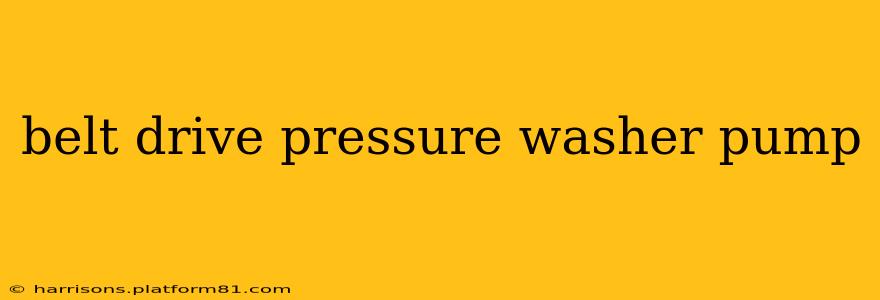Belt drive pressure washer pumps represent a significant step up from direct drive models, offering increased power, durability, and versatility for demanding cleaning tasks. Understanding their mechanics, advantages, and potential drawbacks is key to choosing the right pressure washer for your needs. This comprehensive guide will delve into the intricacies of belt drive pressure washer pumps, answering common questions and providing valuable insights for both professionals and DIY enthusiasts.
How Does a Belt Drive Pressure Washer Pump Work?
A belt drive pressure washer pump uses a belt to transfer power from the engine to the pump. This differs from direct drive pumps, where the engine is directly connected to the pump shaft. The belt acts as a buffer, allowing the engine to run at its optimal speed while the pump operates at a speed best suited for pressure generation and longevity. This system provides several advantages, which we'll explore in detail.
What are the Advantages of a Belt Drive Pressure Washer Pump?
The key benefits of choosing a belt drive system include:
-
Increased Power and Pressure: Belt drives can handle higher engine RPMs without significantly increasing pump speed, resulting in higher pressure outputs compared to direct drive models. This translates to greater cleaning power for tackling tough grime and stubborn stains.
-
Longer Pump Lifespan: The belt acts as a shock absorber, protecting the pump from sudden jolts and vibrations. This reduced stress leads to a longer operational lifespan for the pump, reducing the frequency of replacements and maintenance.
-
Reduced Engine Strain: By decoupling the engine and pump speeds, the belt system reduces stress on the engine, contributing to its overall longevity.
-
Versatility in Engine and Pump Combinations: Belt drive systems offer greater flexibility in matching engine and pump specifications, allowing for optimized performance based on specific cleaning needs. You can pair a more powerful engine with a higher-pressure pump without compromising either component.
What are the Disadvantages of a Belt Drive Pressure Washer Pump?
While offering significant advantages, belt drive systems also have some drawbacks:
-
Increased Complexity: Belt drive systems are mechanically more complex than direct drive systems, leading to a slightly higher potential for maintenance issues like belt slippage or breakage.
-
Higher Initial Cost: The added complexity and components typically translate to a higher initial purchase price compared to direct drive models.
-
Regular Belt Maintenance: Belts require periodic inspection and replacement, adding to the overall maintenance costs over the lifespan of the pressure washer.
How Do I Choose the Right Belt Drive Pressure Washer Pump?
Selecting the appropriate belt drive pressure washer pump involves considering several factors:
-
GPM (Gallons Per Minute): This indicates the volume of water the pump delivers per minute. Higher GPM is suitable for larger cleaning tasks.
-
PSI (Pounds per Square Inch): This measures the water pressure produced by the pump. Higher PSI is necessary for removing stubborn dirt and grime.
-
Engine Horsepower: A more powerful engine provides more power and potentially longer lifespan.
-
Pump Type (Axial or Triplex): Axial pumps are generally less expensive and suitable for lighter tasks, while triplex pumps are more powerful and durable for heavy-duty applications.
What are Common Problems with Belt Drive Pressure Washer Pumps?
Common issues with belt drive pressure washers include:
-
Belt Slippage: This can be caused by worn belts, improper belt tension, or a dirty pulley system.
-
Belt Breakage: This usually results from excessive wear or sudden jolts.
-
Bearing Failure: Regular lubrication is crucial for preventing bearing failure.
How Often Should I Replace the Belt on My Belt Drive Pressure Washer Pump?
Belt replacement frequency depends on usage and conditions. Regular inspection is recommended, and replacements should be made when wear and tear becomes evident or performance degrades. Consult your pressure washer's manual for specific recommendations.
What is the difference between a belt drive and a direct drive pressure washer?
The fundamental difference lies in how the power from the engine is transferred to the pump. In a belt drive system, a belt acts as an intermediary, while in a direct drive system, the engine is directly coupled to the pump. This impacts power transmission, engine longevity, and maintenance requirements.
How much does a belt drive pressure washer pump cost?
The cost varies significantly based on the pump's specifications, GPM, PSI, and overall quality. Expect a price range from several hundred dollars to well over a thousand dollars for higher-end, professional-grade models.
This detailed guide provides a solid foundation for understanding belt drive pressure washer pumps. Remember to always consult your owner's manual for specific maintenance and troubleshooting instructions. Choosing the right pump depends heavily on your individual needs and the types of cleaning tasks you anticipate.
